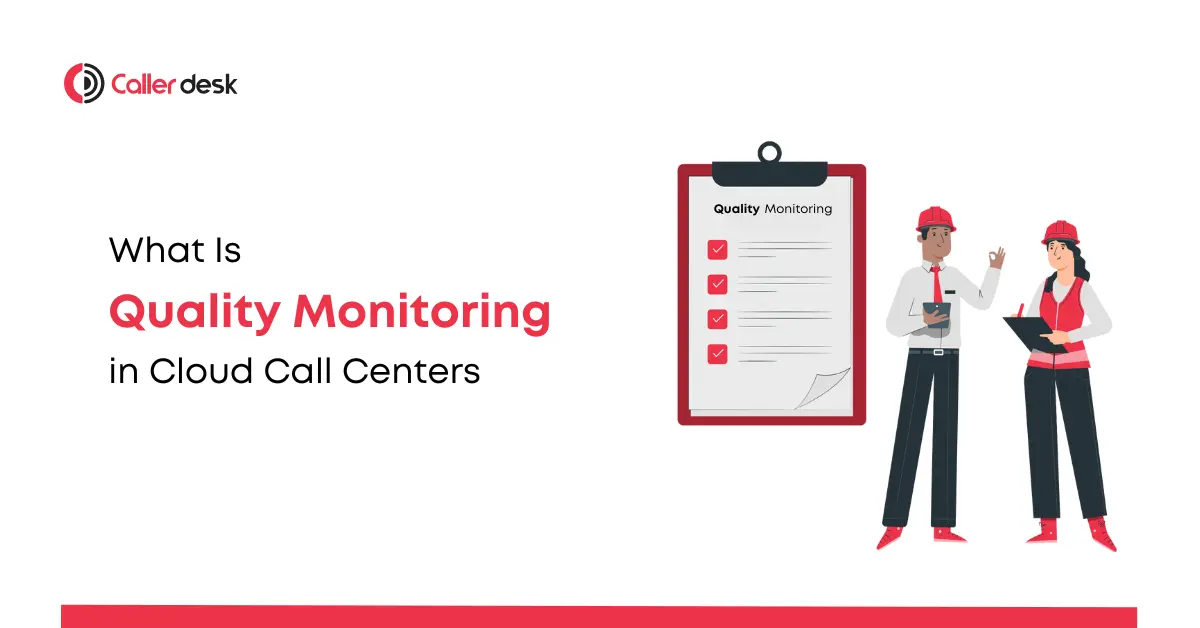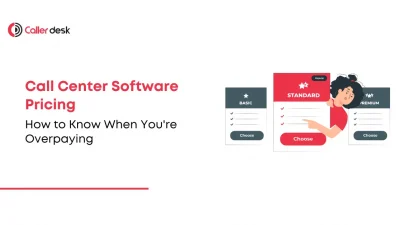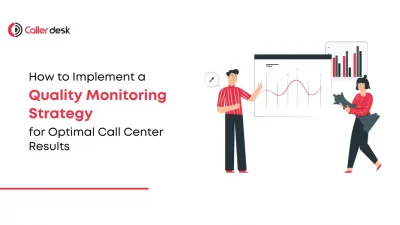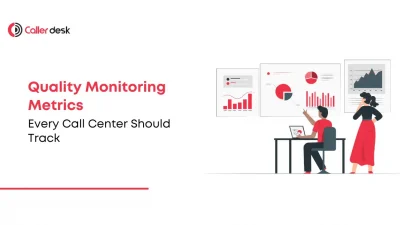Are you truly listening to your customers, or just hearing their words? In today’s competitive business landscape, where customer expectations are higher than ever, the quality of your interactions can determine the success or failure of your business relationships. Simply responding to customer concerns isn’t enough; it’s about how well you address their needs and resolve their issues.
For contact centers, Call Quality Monitoring (CQM) is more than a tool—it’s the foundation of delivering exceptional customer experiences, refining agent performance, and ensuring operational excellence. Whether your goal is to improve customer retention, enhance agent skills, or maintain compliance with industry standards, CQM empowers businesses to consistently meet and exceed expectations.
This guide delves into the essentials of Call Quality Monitoring, exploring its importance, the methodology behind it, the benefits it brings, and actionable best practices to help you leverage it for maximum impact.
What is Call Quality?
At its core, call quality measures how effectively and professionally a contact center agent interacts with a customer. It’s not just about the clarity of speech; it involves:
- Empathy: Does the agent genuinely understand and address the customer’s concerns?
- Problem-Solving: Was the customer’s issue resolved satisfactorily on the first attempt?
- Professionalism: Did the agent adhere to company guidelines and maintain a respectful tone?
- Adherence to Scripts: Was the interaction aligned with established protocols and standards?
High-quality calls leave customers feeling heard, valued, and satisfied, creating stronger relationships and increasing loyalty.
Why Call Quality Monitoring is Important
The quality of customer service is often the defining factor in building trust and loyalty. Consider this: 97% of customers say that the quality of customer service is a key factor in their decision to stay with or leave a brand.
Call Quality Monitoring (CQM) plays a critical role in ensuring that customer interactions consistently meet high standards. Here’s why it’s essential:
- Customer Loyalty and Retention: Exceptional service fosters trust and long-term loyalty, reducing customer churn.
- Agent Development: CQM identifies strengths and weaknesses, helping agents improve their skills and confidence.
- Operational Efficiency: Pinpointing inefficiencies in call handling leads to streamlined operations and reduced costs.
- Regulatory Compliance: In industries like healthcare and finance, compliance with strict regulations is vital. CQM ensures adherence to these standards.
- Enhanced Customer Insights: Monitoring calls provides valuable insights into customer preferences, pain points, and expectations, enabling businesses to make data-driven improvements.
How Does Call Quality Monitoring Work?
Call Quality Monitoring involves a systematic approach to evaluate and improve customer interactions. Here’s how it works:
1. Define Call Quality Standards
Start by determining what makes a call “good.” Define criteria such as:
- Customer satisfaction levels
- Script adherence
- Problem resolution efficiency
- Empathy and tone
Set clear Key Performance Indicators (KPIs) like Customer Satisfaction Scores (CSAT) and First Call Resolution (FCR) to measure performance.
2. Record and Capture Calls
Invest in reliable call recording software to capture all customer interactions. High-quality recordings provide the foundation for detailed analysis, enabling accurate evaluations and actionable insights.
3. Conduct Quality Assessments
Assign a Quality Assurance (QA) team to evaluate recorded calls against the predefined criteria. QA specialists identify areas of excellence and opportunities for improvement, scoring calls to create a performance benchmark.
4. Leverage Advanced Analytics
Use AI-powered tools like speech analytics to automatically analyze calls for tone, sentiment, and compliance. These tools identify patterns and trends across interactions, making it easier to spot systemic issues.
5. Deliver Feedback and Training
Provide agents with detailed feedback, highlighting:
- Strengths: What they did well.
- Areas for Improvement: Specific actions to enhance performance.
Pair feedback with tailored training sessions to ensure continuous growth.
6. Continuous Monitoring and Optimization
CQM is an ongoing process. Regularly revisit KPIs, refine evaluation criteria, and update training programs to ensure the system evolves with customer needs and industry trends.
Benefits of Call Quality Monitoring in Cloud Call Centers
1. Happier Customers
Satisfied customers are more likely to stay loyal and recommend your brand. CQM ensures every call reflects professionalism, empathy, and efficiency, leading to better customer experiences.
2. Empowered Agents
Regular feedback helps agents build confidence and improve their skills. Over time, this leads to higher efficiency, better communication, and greater job satisfaction.
3. Streamlined Operations
By identifying bottlenecks and inefficiencies, CQM enables smoother workflows. Optimized processes reduce call handling times and enhance overall productivity.
4. Regulatory Compliance
CQM ensures agents follow industry regulations and company policies, reducing the risk of legal issues and protecting your business’s reputation.
5. Actionable Customer Insights
Analyzing call data reveals valuable trends about customer preferences and pain points, helping businesses adapt their services to better meet customer needs.
6. Proactive Problem Solving
Early identification of issues prevents escalations, creating a seamless experience for both customers and agents.
Best Practices for Effective Call Quality Monitoring
1. Invest in the Right Tools
Use advanced platforms like CallerDesk, which offer real-time analytics, customizable dashboards, and AI-powered monitoring. These tools make it easier to evaluate performance and identify areas for improvement.
2. Focus on Key Metrics
Track essential metrics such as:
- CSAT (Customer Satisfaction Score): Measures how satisfied customers are after their interaction.
- FCR (First Call Resolution): Tracks the percentage of issues resolved on the first call.
- AHT (Average Handle Time): Monitors the time taken to resolve customer inquiries.
3. Train Continuously
Use CQM data to create personalized training programs. Offer regular coaching sessions to address specific weaknesses and reinforce strengths.
4. Leverage AI for Automation
AI-driven tools can automatically review and analyze calls, saving time and allowing QA teams to focus on critical cases.
5. Personalize Customer Interactions
Integrate call data with CRM systems to provide personalized experiences, such as addressing customers by name and referencing their previous interactions.
6. Maintain Open Communication
Encourage a culture of transparency by sharing feedback regularly with agents. Recognize their achievements and provide constructive guidance for improvement.
Conclusion
Call Quality Monitoring is no longer optional—it’s a necessity for any business striving to deliver exceptional customer experiences. From ensuring compliance to enhancing agent performance, CQM provides the tools and insights needed to create lasting value for customers and businesses alike.
By leveraging advanced technologies, focusing on continuous improvement, and prioritizing customer satisfaction, businesses can transform their call centers into hubs of excellence.
Ready to elevate your call center performance? Contact CallerDesk today to discover how our cutting-edge CQM solutions can empower your team and delight your customers.
Frequently asked questions
1. What is call quality monitoring in cloud call centers?
2. Why is call quality monitoring important for cloud call centers?
3. What metrics are commonly used in call quality monitoring?
Customer Satisfaction Score (CSAT): Measures customer happiness.
First Call Resolution (FCR): Tracks the percentage of issues resolved on the first call.
Average Handle Time (AHT): Monitors the time agents take to resolve a call.
Net Promoter Score (NPS): Measures customer loyalty.
4. How does AI improve call quality monitoring?
5. How can businesses implement effective call quality monitoring?
Setting clear evaluation criteria.
Using reliable call recording software.
Leveraging AI tools for analysis.
Providing regular feedback to agents.
Tracking performance metrics like CSAT and FCR.





